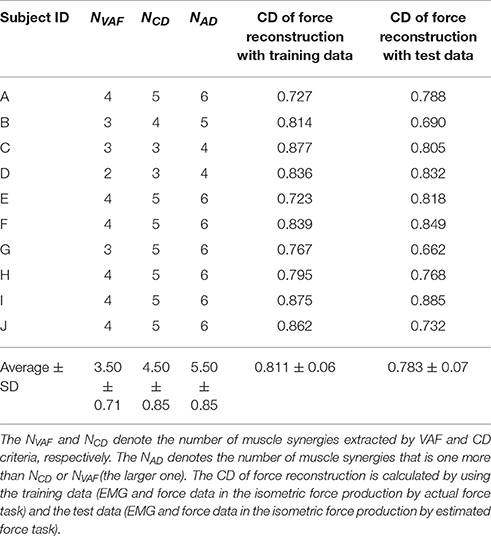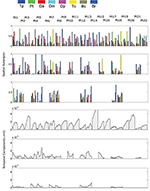


The decomposition of multiple surface electromyographic (EMG) signals can be used to extract these synergies. Low-dimensional modules formed by muscles activated in synchrony, referred to as muscle synergies, have been proposed as building blocks that may simplify the construction of motor behaviors (Ivanenko et al., 2003 'Avella and Bizzi, 2005 Ting and McKay, 2007 Torres-Oviedo and Ting, 2007 Ting and Chvatal, 2010).

For example, at the neuromuscular level, the same movement can be performed by different muscle coordination strategies across trials (Torres-Oviedo and Ting, 2007) and/or between subjects (Ryan and Gregor, 1992 Hug et al., 2004).

Understanding how the central nervous system controls movement of the human body is a challenging question due to the biomechanical redundancy of the neuromusculoskeletal system, which is referred to as Bernstein's degrees of freedom problem (Bernstein, 1967). This confirms that the muscle synergies are consistent across participants, even during a skilled motor task that requires learning. Although variability was found (especially for synergy #3), the gymnasts exhibited gross similar neuromuscular strategies when performing backward giant swings. By keeping the synergy activation coefficients constant, we obtained an averaged VAF across all pairwise comparisons of 72 ± 5%. For the synergy activation coefficients, r max-values were 0.96 ± 0.03, 0.92 ± 0.03, and 0.95 ± 0.03, for synergy #1, #2, and #3, respectively. By keeping the muscle synergy vectors constant, we obtained an averaged VAF across all pairwise comparisons of 79 ± 4%. The coefficients of correlation of the muscle synergy vectors among the participants were 0.83 ± 0.08, 0.86 ± 0.09, and 0.66 ± 0.28 for synergy #1, #2, and #3, respectively. Three muscle synergies explained 89.9 ± 2.0% of the variance accounted for (VAF). We performed a further analysis to verify that the muscle synergies (in terms of muscle synergy vectors or synergy activation coefficients) extracted for one gymnast accounted for the EMG patterns of the other gymnasts. First, the coefficient of correlation ( r) and circular cross-correlation ( r max) were calculated to assess similarities in the mechanical patterns, EMG patterns, and muscle synergies between gymnasts. Muscle synergies were extracted by non-negative matrix factorization (NMF), providing two components: muscle synergy vectors and synergy activation coefficients. Both kinematics and electromyographic (EMG) patterns of 12 upper-limb and trunk muscles were recorded. This cyclic movement is interesting because it requires learning, as untrained subjects are unable to perform this task. We studied a population of experienced gymnasts during backward giant swings on the high bar. The purpose of the present study was to determine whether subjects who have learned a complex motor skill exhibit similar neuromuscular control strategies.


 0 kommentar(er)
0 kommentar(er)
